A Comparative Study of Deterministic and Stochastic Models of Microstructure Evolution during Multi-Step Hot Deformation of Steels
Abstract
:1. Introduction
2. Constitutive Model Based on Internal Variables
2.1. Deterministic Model
2.2. Case Study—Deterministic Internal Variable Model
3. Stochastic Model for Hot Forming
3.1. State-of-the-Art in Stochastic Approach to Modelling Recrystallization
3.2. Mathematical Background
3.3. Main Equations of the Model
3.4. Identification
3.5. Numerical Tests
4. Case Studies—Stochastic Model
4.1. Varying Strain Rate Test
4.2. Industrial Hot Strip Rolling Process
5. Future Applications of the Stochastic Model
5.1. Laminar Cooling of Hot Rolled Strips
5.2. Cooling of Rods in the Stelmor System
6. Summary
- Capability to predict histograms of different microstructural features instead of their average values is the main advantage of the model. It reflects real-world situations more adequately than models using averaged values of dislocation density or grain size.
- All considered models are classified as mean-field models that do not needing explicit representation of the microstructure. In consequence, their computing costs are low.
- Due to the stochastic nature of Equation (9), the repeatability of histograms depends on the number of points. However, it can be kept at a reasonably low level depending on the design of the experiment. In considered cases, we observed that 20,000 simulations with 10 bins allowed us to reduce differences between generated histograms to the level of 3%.
- In the Inverse Analysis, error on target to computed histogram was decreased to 6%, which is a reasonable score bearing in mind that comparison of the two histograms at exactly the same parameters can result in 3% difference.
Author Contributions
Funding
Institutional Review Board Statement
Informed Consent Statement
Data Availability Statement
Conflicts of Interest
References
- Gladman, T. The Physical Metallurgy of Microalloyed Steels; The Institute of Materials: London, UK, 1997. [Google Scholar]
- Isasti, N.; Jorge-Badiola, D.; Taheri, M.L.; Uranga, P. Microstructural and precipitation characterization in Nb-Mo microalloyed steels: Estimation of the contributions to the strength. Met. Mater. Int. 2014, 20, 807–817. [Google Scholar] [CrossRef]
- Chang, Y.; Haase, C.; Szeliga, D.; Madej, L.; Hangen, U.; Pietrzyk, M.; Bleck, W. Compositional heterogeneity in multiphase steels: Characterization and influence on local properties. Mater. Sci. Eng. A 2021, 827, 142078. [Google Scholar] [CrossRef]
- Bhadeshia, H.K.D.H. Martensite and bainite in steels: Transformation mechanism & mechanical properties. J. Phys. IV 1997, 7, C5-367–C5-376. [Google Scholar]
- Bhadeshia, H.K.D.H. High performance bainitic steels. Mater. Sci. Forum 2005, 500–501, 63–74. [Google Scholar]
- Chang, Y.; Lin, M.; Hangen, U.; Richter, S.; Haase, C.; Bleck, W. Revealing the relation between microstructural heterogeneities and local mechanical properties of complex-phase steel by correlative electron microscopy and nanoindentation characterization. Mater. Des. 2021, 203, 109620. [Google Scholar] [CrossRef]
- Heibel, S.; Dettinger, T.; Nester, W.; Clausmeyer, T.; Tekkaya, A.E. Damage mechanisms and mechanical properties of high-strength multi-phase steels. Materials 2018, 11, 761. [Google Scholar] [CrossRef]
- Li, S.; Vajragupta, N.; Biswas, A.; Tang, W.; Wang, H.; Kostka, A.; Yang, X.; Hartmaier, A. Effect of microstructure heterogeneity on the mechanical properties of friction stir welded reduced activation ferritic/martensitic steel. Scr. Mater. 2022, 207, 114306. [Google Scholar] [CrossRef]
- Hassan, S.F.; Al-Wadei, H. Heterogeneous microstructure of low-carbon microalloyed steel and mechanical properties. J. Mater. Eng. Perform. 2020, 29, 7045–7051. [Google Scholar] [CrossRef]
- Igwemezie, V.C.; Agu, P.C. Development of bainitic steels for engineering applications. Int. J. Eng. Res. Technol. 2014, 3, 2698–2711. [Google Scholar]
- Adamczyk-Cieślak, B.; Koralnik, M.; Kuziak, R.; Majchrowicz, K.; Mizera, J. Studies of bainitic steel for rail applications based on carbide-free, low-alloy steel. Metall. Mater. Trans. A 2021, 52, 5429–5442. [Google Scholar] [CrossRef]
- Hase, K.; Hoshino, T.; Amano, K. New extremely low carbon bainitic high-strength steel bar having excellent machinability and toughness produced by TPCP technology. Kawasaki Steel Tech. Rep. 2002, 47, 35–41. [Google Scholar]
- Kawalla, R.; Zając, S.; Kuziak, R. Cold Heading Quality Low-Carbon Ultra-High-Strength Bainitic Steels, Acronym: Coheadbain, European Commission, Directorate-General for Research and Innovation, Publications Office 2010. Available online: https://data.europa.eu/doi/10.2777/81813 (accessed on 20 April 2023).
- Kuziak, R.; Kawalla, R.; Waengler, S. Advanced high strength steels for automotive industry. Arch. Civ. Mech. Eng. 2008, 8, 103–117. [Google Scholar] [CrossRef]
- Singh, M.K. Application of steel in automotive industry. Int. J. Emerg. Technol. Adv. Eng. 2016, 6, 246–253. [Google Scholar]
- Tasan, C.C.; Diehl, M.; Yan, D.; Bechtold, M.; Roters, F.; Schemmann, L.; Zheng, C.; Peranio, N.; Ponge, D.; Koyama, M.; et al. An overview of Dual-Phase steels: Advances in microstructure-oriented processing and micromechanically guided design. Annu. Rev. Mater. Res. 2015, 45, 391–431. [Google Scholar] [CrossRef]
- Karelova, A.; Krempaszky, C.; Werner, E.; Tsipouridis, P.; Hebesberger, T.; Pichler, A. Hole expansion of dual-phase and complex-phase AHS steels—Effect of edge conditions. Steel Res. Int. 2009, 80, 71–77. [Google Scholar]
- Szeliga, D.; Chang, Y.; Bleck, W.; Pietrzyk, M. Evaluation of using distribution functions for mean field modelling of multiphase steels. Procedia Manuf. 2019, 27, 72–77. [Google Scholar] [CrossRef]
- Edmonds, D.V.; Cochrane, R.C. Structure-property relationships in bainitic steels. Metall. Trans. A 1990, 21A, 1527–1540. [Google Scholar] [CrossRef]
- Adamczyk-Cieślak, B.; Koralnik, M.; Kuziak, R.; Smaczny, M.; Zygmunt, T.; Mizera, J. Effects of heat treatment parameters on the microstructure and properties of bainitic steel. J. Mater. Eng. Perform. 2019, 28, 7171–7180. [Google Scholar] [CrossRef]
- Garcia-Mateo, C.; Caballero, F.G. The role of retained austenite on tensile properties of steels with bainitic microstructures. Mater. Trans. 2005, 46, 1839–1846. [Google Scholar] [CrossRef]
- Sung, H.K.; Shin, S.Y.; Hwang, B.; Lee, C.G.; Kim, N.J.; Lee, S. Effects of carbon equivalent and cooling rate on tensile and Charpy impact properties of high-strength bainitic steels. Mater. Sci. Eng. A 2011, 530, 530–538. [Google Scholar] [CrossRef]
- Guo, L.; Roelofs, H.; Lembke, M.I.; Bhadeshia, H.K.D.H. Modelling of size distribution of blocky retained austenite in Si-containing bainitic steels. Mater. Sci. Technol. 2017, 33, 54–62. [Google Scholar] [CrossRef]
- Grossterlinden, G.P.R.; Aldazabal, J.; Garcia, O.; Dickert, H.H.; Katsamas, A.I.; Kamoutsi, E.; Haidemenopoulos, G.N.; Hebesberger, T.; Satzinger, K. Design of Bainite in Steels from Homogeneous and Inhomogeneous Microstructures Using Physical Approaches, RFCS Project Bainite Design, Grant Agreement RFSR-CT-2007-00022; Publication Office of the European Union: Luxembourg, 2013. [Google Scholar]
- Maire, L.; Fausty, J.; Bernacki, M.; Bozzolo, N.; de Micheli, P.; Moussa, C. A new topological approach for the mean field modeling of dynamic recrystallization. Mater. Des. 2018, 146, 194–207. [Google Scholar] [CrossRef]
- Bleck, W.; Prahl, U.; Hirt, G.; Bambach, M. Designing new forging steels by ICMPE. In Advances in Production Technology, Lecture Notes in Production Engineering; Brecher, C., Ed.; Springer: Berlin/Heidelberg, Germany, 2015; pp. 85–98. [Google Scholar]
- Madej, L.; Rauch, L.; Perzyński, K.; Cybulka, P. Digital Material Representation as an efficient tool for strain inhomogeneities analysis at the micro scale level. Arch. Civ. Mech. Eng. 2011, 11, 661–679. [Google Scholar] [CrossRef]
- Bos, C.; Mecozzi, M.G.; Hanlon, D.N.; Aarnts, M.P.; Sietsma, J. Application of a three-dimensional microstructure evolution model to identify key process settings for the production of dual-phase steels. Metall. Mater. Trans. A 2011, 42A, 3602–3610. [Google Scholar] [CrossRef]
- Song, W.; Prahl, U.; Bleck, W.; Mukherjee, K. Phase-field simulations of bainitic phase transformation in 100Cr6, TMS—140th Annual Meeting and Exhibition. Orlando 2011, 2, 417–425. [Google Scholar]
- Osipov, N.; Gourgues-Lorenzon, A.-F.; Marini, B.; Mounoury, V.; Nguyen, F.; Cailletaud, G. FE modelling of bainitic steels using crystal plasticity. Philos. Mag. 2008, 88, 3757–3777. [Google Scholar] [CrossRef]
- Szeliga, D.; Czyżewska, N.; Klimczak, K.; Kusiak, J.; Kuziak, R.; Morkisz, P.; Oprocha, P.; Pidvysotsk’yy, V.; Pietrzyk, M.; Przybyłowicz, P. Formulation, identification and validation of a stochastic internal variables model describing the evolution of metallic materials microstructure during hot forming. Int. J. Mater. Form. 2022, 15, 53. [Google Scholar] [CrossRef]
- Tashkinov, M. Statistical methods for mechanical characterization of randomly reinforced media. Mech. Adv. Mater. Mod. Process. 2017, 3, 18. [Google Scholar] [CrossRef]
- Cameron, B.C.; Tasan, C.C. Microstructural damage sensitivity prediction using spatial statistics. Sci. Rep. 2019, 9, 2774. [Google Scholar] [CrossRef] [PubMed]
- Napoli, G.; Di Schino, A. Statistical modelling of recrystallization and grain growth phenomena in stainless steels: Effect of initial grain size distribution. Open Eng. 2018, 8, 373–376. [Google Scholar] [CrossRef]
- Klimczak, K.; Oprocha, P.; Kusiak, J.; Szeliga, D.; Morkisz, P.; Przybyłowicz, P.; Czyżewska, N.; Pietrzyk, M. Inverse problem in stochastic approach to modelling of microstructural parameters in metallic materials during processing. Math. Probl. Eng. 2022, 9690742. [Google Scholar] [CrossRef]
- Szeliga, D.; Czyżewska, N.; Klimczak, K.; Kusiak, J.; Kuziak, R.; Morkisz, P.; Oprocha, P.; Pietrzyk, M.; Poloczek, Ł.; Przybyłowicz, P. Stochastic model describing evolution of microstructural parameters during hot rolling of steel plates and strips. Arch. Civ. Mech. Eng. 2022, 22, 239. [Google Scholar] [CrossRef]
- Pietrzyk, M.; Madej, Ł.; Rauch, Ł.; Szeliga, D. Computational Materials Engineering: Achieving High Accuracy and Efficiency in Metals Processing Simulations; Butterworth-Heinemann: Oxford, UK; Elsevier: Amsterdam, The Netherlands, 2015. [Google Scholar]
- Urcola, J.J.; Sellars, C.M. Effect of changing strain rate on stress-strain behaviour during high temperature deformation. Acta Metall. 1987, 35, 2637–2647. [Google Scholar] [CrossRef]
- Rao, K.P.; Prasad, Y.K.D.V.; Hawbolt, E.B. Hot deformation studies on a low-carbon steel: Part 2—An algorithm for the flow stress determination under varying process conditions. J. Mater. Process. Technol. 1996, 56, 908–917. [Google Scholar] [CrossRef]
- Taylor, G.I. The mechanism of plastic deformation of crystals. Part I—Theoretical, Proc. of the Royal Society of London A: Mathematical. Phys. Eng. Sci. 1934, 145, 362–387. [Google Scholar]
- Mecking, H.; Kocks, U.F. Kinetics of flow and strain-hardening. Acta Metall. 1981, 29, 1865–1875. [Google Scholar] [CrossRef]
- Estrin, Y.; Mecking, H. A unified phenomenological description of work hardening and creep based on one-parameter models. Acta Metall. 1984, 32, 57–70. [Google Scholar] [CrossRef]
- Sun, Z.C.; Yang, H.; Han, G.J.; Fan, X.G. A numerical model based on internal-state-variable method for the microstructure evolution during hot-working process of TA15 titanium alloy. Mater. Sci. Eng. A 2010, 527, 3464–3471. [Google Scholar] [CrossRef]
- Zhuang, Z.; Liu, Z.; Cui, Y. Dislocation Mechanism-Based Crystal Plasticity: Theory and Computation at the Micron and Submicron Scale; Academic Press: London, UK, 2019. [Google Scholar]
- Buzolin, R.H.; Lasnik, M.; Krumphals, A.; Poletti, M.C. A dislocation based model for the microstructure evolution and the flow stress of a Ti5553 alloy. Int. J. Plast. 2021, 136, 102862. [Google Scholar] [CrossRef]
- Lin, Y.C.; Wen, D.-X.; Chen, M.-S.; Liu, Y.-X.; Chen, X.-M.; Ma, X. Improved dislocation density-based models for describing hot deformation behaviors of a NI-based superalloy. J. Mater. Res. 2016, 31, 2415–2429. [Google Scholar] [CrossRef]
- Lisiecka-Graca, P.; Bzowski, K.; Majta, J.; Muszka, K. A dislocation density-based model for the work hardening and softening behaviors upon stress reversal. Arch. Civ. Mech. Eng. 2021, 21, 84. [Google Scholar] [CrossRef]
- Bureau, R.; Poletti, M.C.; Sommitsch, C. Modelling the flow stress of aluminum alloys during hot and cold deformation. In Proceedings of the XXII Conference Computer Methods in Materials Technology KomPlasTech, Krynica-Zdrój, Poland, 11–14 January 2015. [Google Scholar]
- Sandstrom, R.; Lagneborg, R. A model for hot working occurring by recrystallization. Acta Metall. 1975, 23, 387–398. [Google Scholar] [CrossRef]
- Davies, C.H.J. Dynamics of the evolution of dislocation populations. Scr. Metall. Mater 1994, 30, 349–353. [Google Scholar] [CrossRef]
- Czyżewska, N.; Kusiak, J.; Morkisz, P.; Oprocha, P.; Pietrzyk, M.; Przybyłowicz, P.; Rauch, Ł.; Szeliga, D. On mathematical aspects of evolution of dislocation density in metallic materials. IEEE Access 2022, 10, 86793–86812. [Google Scholar] [CrossRef]
- Hairer, E.; Nørsett, S.P.; Wanner, G. Solving Ordinary Differential Equations: I. Nonstiff Problems, 2nd ed.; Springer: New York, NY, USA, 2008. [Google Scholar]
- Butcher, J.C. Numerical Methods for Ordinary Differential Equations, 3rd ed.; Wiley: Chichester, UK, 2016. [Google Scholar]
- Foryś, U.; Bodnar, M.; Poleszczuk, J. Negativity of delayed induced oscillations in a simple linear DDE. Appl. Math. Lett. 2011, 24, 982–986. [Google Scholar] [CrossRef]
- Huang, K.; Logé, R.E. A review of dynamic recrystallization phenomena in metallic materials. Mater. Des. 2016, 111, 548–574. [Google Scholar] [CrossRef]
- Bernacki, M.; Resk, H.; Coupez, T.; Logé, R.E. Finite element model of primary recrystallization in polycrystalline aggregates using a level set framework. Model. Simul. Mater. Sci. Eng. 2009, 17, 064006. [Google Scholar] [CrossRef]
- Tutcuoglu, A.D.; Vidyasagar, A.; Bhattacharya, K.; Kochmann, D.M. Stochastic modeling of discontinuous dynamic recrystallization at finite strains in hcp metals. J. Mech. Phys. Solids 2019, 122, 590–612. [Google Scholar] [CrossRef]
- Czarnecki, M.; Sitko, M.; Madej, Ł. The role of neighborhood density in the random cellular automata model of grain growth. Comput. Methods Mater. Sci. 2021, 21, 129–137. [Google Scholar] [CrossRef]
- Lu, X.; Yvonnet, J.; Papadopoulos, L.; Kalogeris, I.; Papadopoulos, V. A stochastic FE2 data-driven method for nonlinear multiscale modelling. Materials 2021, 14, 2875. [Google Scholar] [CrossRef]
- Bernacki, M.; Chastel, Y.; Coupez, T.; Loge, R. Level set framework for the numerical modelling of primary recrystallization in polycrystalline materials. Scr. Mater. 2008, 58, 1129–1132. [Google Scholar] [CrossRef]
- Potts, R.B. Some generalized order-disorder transformations. In Mathematical Proceedings of the Cambridge Philosophical Society; Cambridge University Press: Cambridge, UK, 1952; Volume 48, pp. 106–109. [Google Scholar] [CrossRef]
- Tutcuoglu, A.D. Stochastic Multiscale Modeling of Dynamic Recrystallization. Ph.D. Thesis, California Institute of Technology CalTech, Pasadena, CA, USA, 2019. [Google Scholar]
- Piękoś, K.; Tarasiuk, J.; Wierzbanowski, K.; Bacroix, B. Stochastic vertex model of recrystallization. Comput. Mater. Sci. 2008, 42, 36–42. [Google Scholar] [CrossRef]
- Bernard, P.; Bag, S.; Huang, K.; Loge, R. A two-site mean field model of discontinuous dynamic recrystallization. Mater. Sci. Eng. A 2011, 528, 7357–7367. [Google Scholar] [CrossRef]
- Cha, S.-H.; Srihari, S.N. On measuring the distance between histograms. Pattern Recognit. 2002, 35, 1355–1370. [Google Scholar] [CrossRef]
- Gavrus, A.; Massoni, E.; Chenot, J.L. An inverse analysis using a finite element model for identification of rheological parameters. J. Mater. Process. Technol. 1996, 60, 447–454. [Google Scholar] [CrossRef]
- Szeliga, D.; Gawąd, J.; Pietrzyk, M. Inverse analysis for identification of rheological and friction models in metal forming. Comput. Methods Appl. Mech. Eng. 2006, 195, 6778–6798. [Google Scholar] [CrossRef]
- Poloczek, Ł.; Kuziak, R.; Pidvysotsk’yy, V.; Szeliga, D.; Kusiak, J.; Pietrzyk, M. Physical and numerical simulations to predict distribution of microstructural features during thermomechanical processing of steels. Materials 2022, 15, 1660. [Google Scholar] [CrossRef] [PubMed]
- Pietrzyk, M. Finite element simulation of large plastic deformation. J. Mater. Process. Technol. 2000, 106, 223–229. [Google Scholar] [CrossRef]
- Szeliga, D.; Czyżewska, N.; Kusiak, J.; Morkisz, P.; Oprocha, P.; Pietrzyk, M.; Przybyłowicz, P. Accounting for random character of recrystallization and uncertainty of process parameters in the modelling of phase transformations in steels. Mater. Res. Proc. 2023. accepted for publication. [Google Scholar]
- Bzowski, K.; Kitowski, J.; Kuziak, R.; Uranga, P.; Gutierrez, I.; Jacolot, R.; Rauch, Ł.; Pietrzyk, M. Development of the material database for the VirtRoll computer system dedicated to design of an optimal hot strip rolling technology. Comput. Methods Mater. Sci. 2017, 17, 225–246. [Google Scholar]
- Pietrzyk, M.; Kusiak, J.; Kuziak, R.; Madej, Ł.; Szeliga, D.; Gołąb, R. Conventional and multiscale modelling of microstructure evolution during laminar cooling of DP steel strips. Metall. Mater. Trans. B 2014, 46B, 497–506. [Google Scholar]
- Hodgson, P.D.; Gibbs, R.K. A mathematical model to predict the mechanical properties of hot rolled C-Mn and microalloyed steels. ISIJ Int. 1992, 32, 1329–1338. [Google Scholar] [CrossRef]
- Piwowarczyk, M.; Wolańska, N.; Wilkus, M.; Pietrzyk, M.; Rauch, Ł.; Kuziak, R.; Pidvysots’kyy, V.; Radwański, K. Physical and numerical simulation of production chain of fasteners manufactured of wire rod of Cr32B4 steel control-cooled in the Stelmor process to develop the multiphase microstructure. Comput. Methods Mater. Sci. 2023, 23. submitted. [Google Scholar]
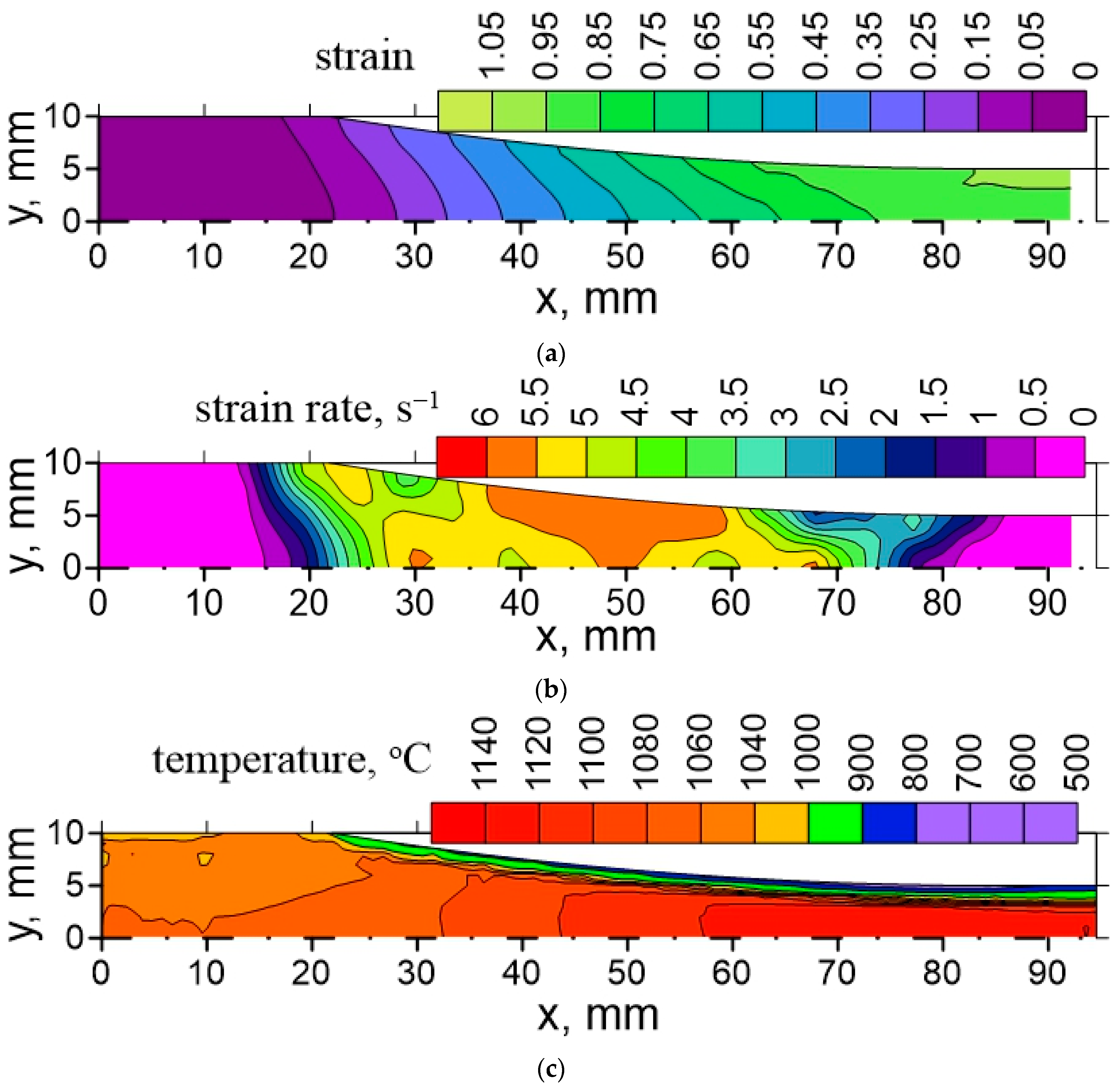
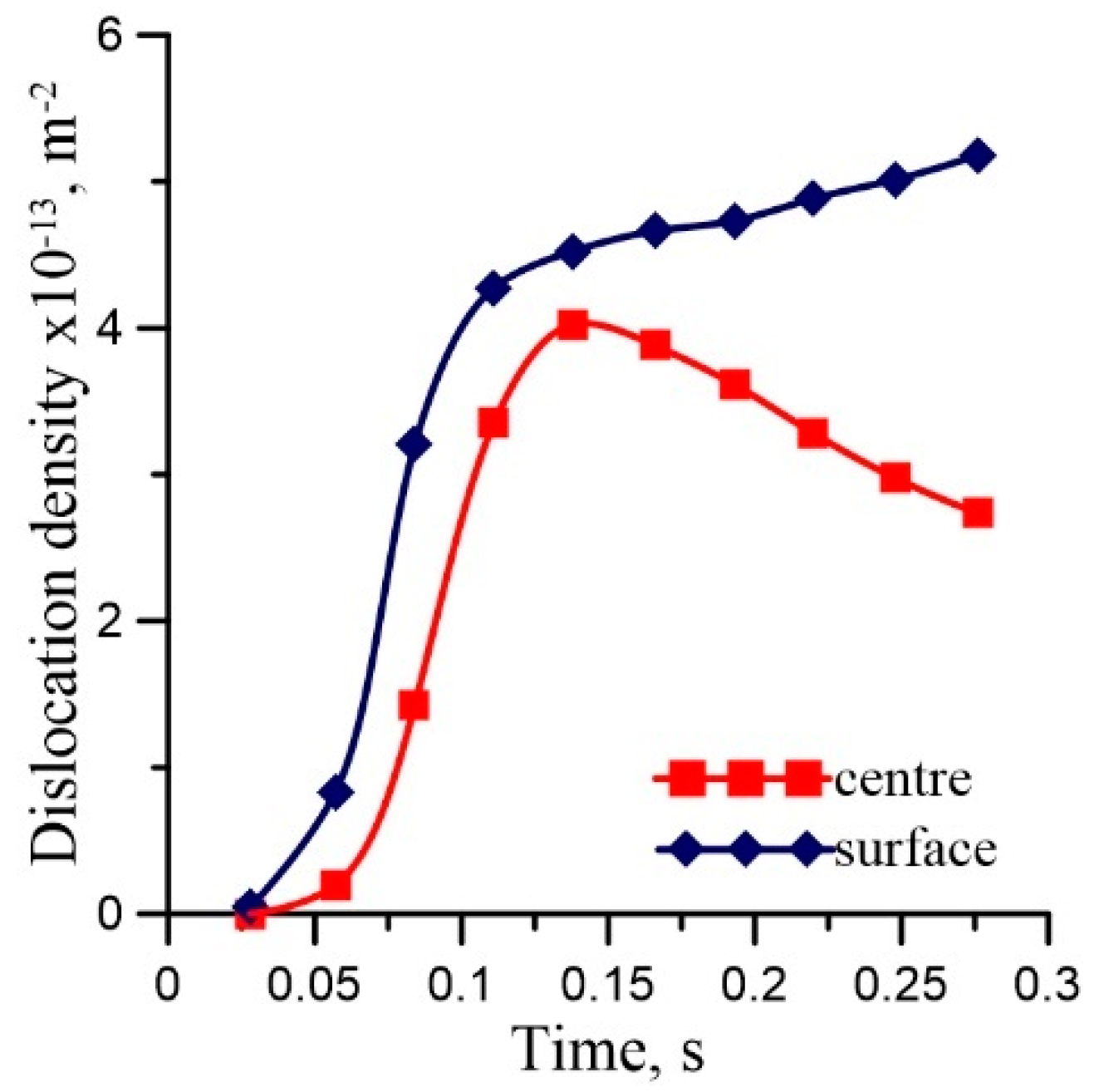


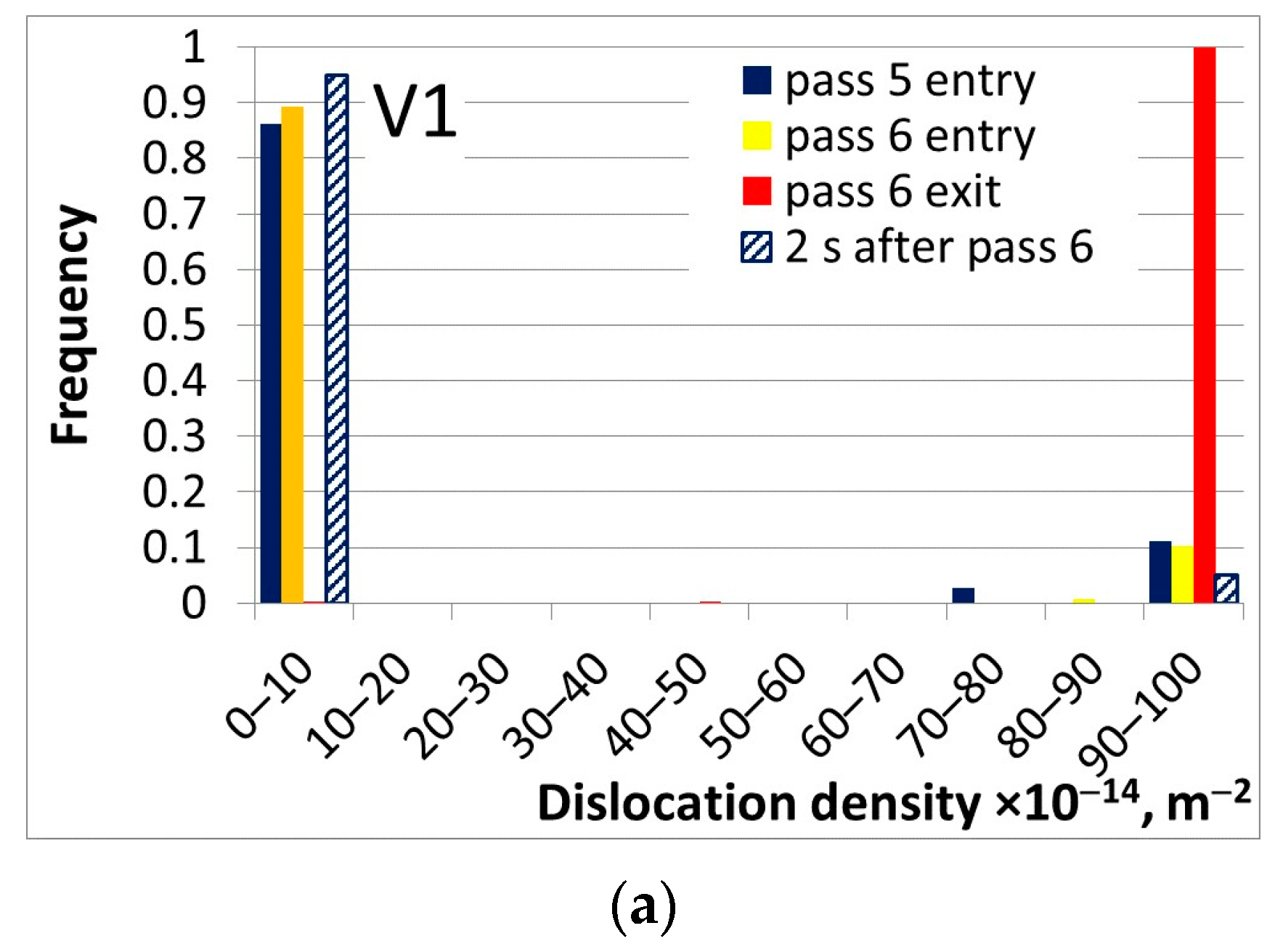

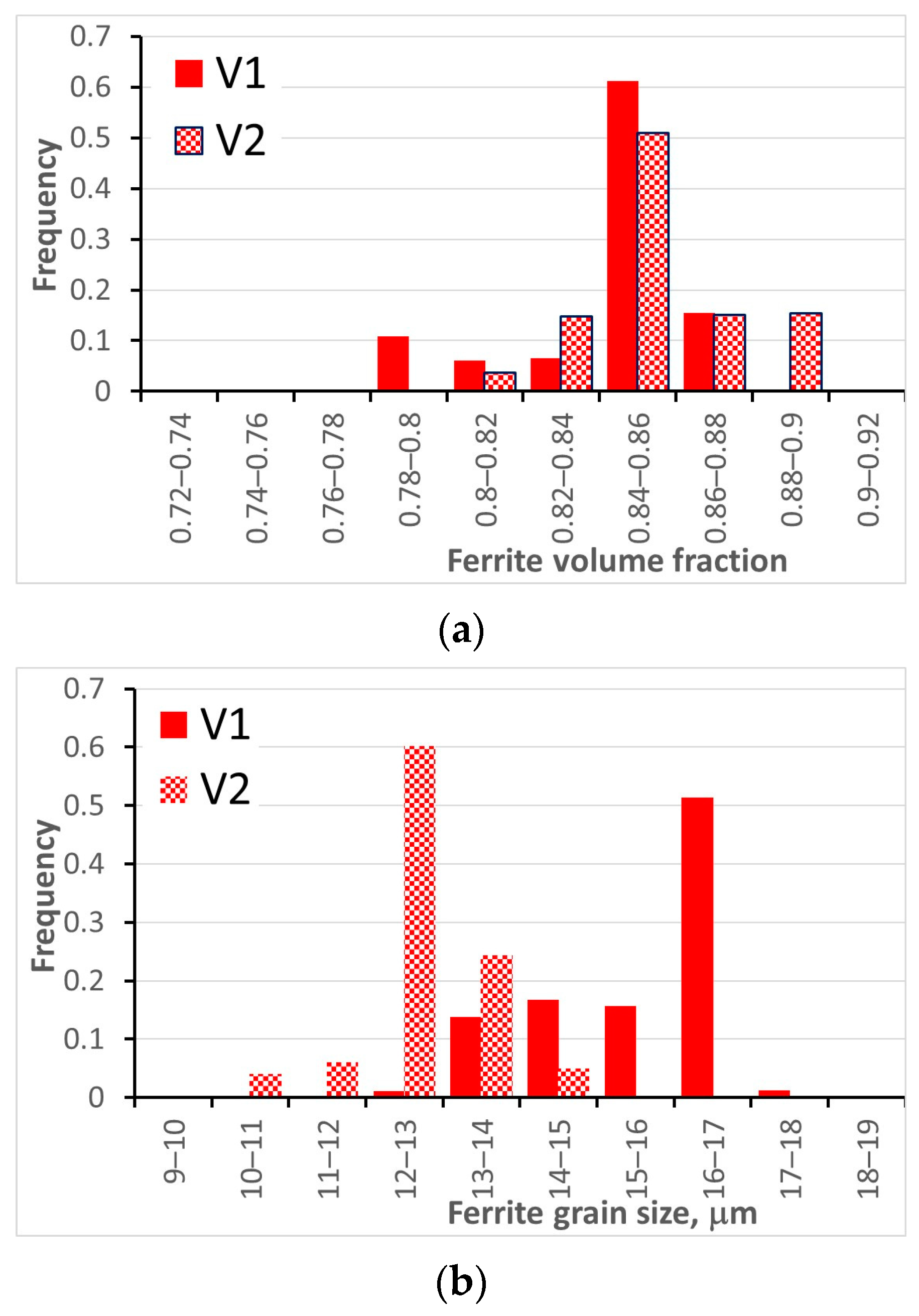
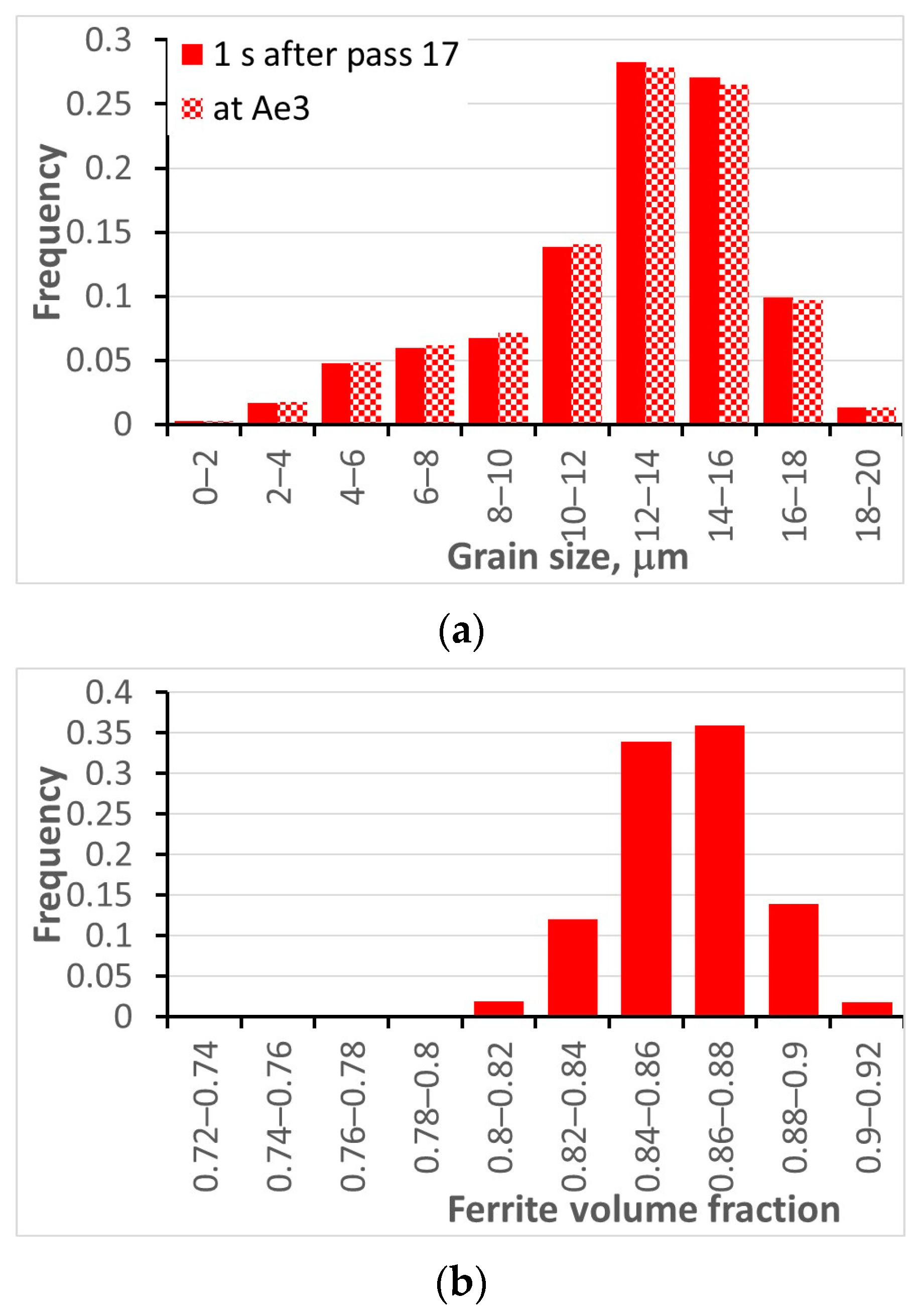
Disclaimer/Publisher’s Note: The statements, opinions and data contained in all publications are solely those of the individual author(s) and contributor(s) and not of MDPI and/or the editor(s). MDPI and/or the editor(s) disclaim responsibility for any injury to people or property resulting from any ideas, methods, instructions or products referred to in the content. |
© 2023 by the authors. Licensee MDPI, Basel, Switzerland. This article is an open access article distributed under the terms and conditions of the Creative Commons Attribution (CC BY) license (https://creativecommons.org/licenses/by/4.0/).
Share and Cite
Oprocha, P.; Czyżewska, N.; Klimczak, K.; Kusiak, J.; Morkisz, P.; Pietrzyk, M.; Potorski, P.; Szeliga, D. A Comparative Study of Deterministic and Stochastic Models of Microstructure Evolution during Multi-Step Hot Deformation of Steels. Materials 2023, 16, 3316. https://doi.org/10.3390/ma16093316
Oprocha P, Czyżewska N, Klimczak K, Kusiak J, Morkisz P, Pietrzyk M, Potorski P, Szeliga D. A Comparative Study of Deterministic and Stochastic Models of Microstructure Evolution during Multi-Step Hot Deformation of Steels. Materials. 2023; 16(9):3316. https://doi.org/10.3390/ma16093316
Chicago/Turabian StyleOprocha, Piotr, Natalia Czyżewska, Konrad Klimczak, Jan Kusiak, Paweł Morkisz, Maciej Pietrzyk, Paweł Potorski, and Danuta Szeliga. 2023. "A Comparative Study of Deterministic and Stochastic Models of Microstructure Evolution during Multi-Step Hot Deformation of Steels" Materials 16, no. 9: 3316. https://doi.org/10.3390/ma16093316
APA StyleOprocha, P., Czyżewska, N., Klimczak, K., Kusiak, J., Morkisz, P., Pietrzyk, M., Potorski, P., & Szeliga, D. (2023). A Comparative Study of Deterministic and Stochastic Models of Microstructure Evolution during Multi-Step Hot Deformation of Steels. Materials, 16(9), 3316. https://doi.org/10.3390/ma16093316





